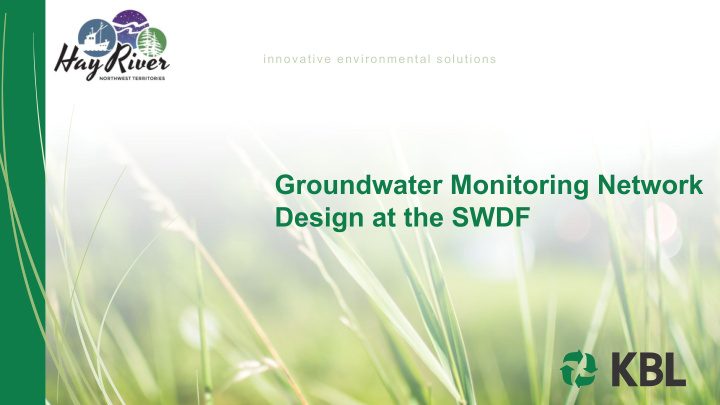



innovative environmental solutions I Groundwater Monitoring Network I Design at the SWDF C. KBL
Background Third Party Consultant review of historical groundwater monitoring data and recommendations. Review included an in depth review of: Physical and Geological setting Topography Surficial Geology and Hydrogeology (includes bedrock geology, hydrochemistry) Preliminary Investigations Analysis of Historical to Present Groundwater Monitoring Data Summary of Finding and Recommendations O KBL
Background Wells Two types of groundwater chemistry on site SNP0053-5b is a viable background well High SO 4 and Cl - are naturally occurring in SNP0053-5b The addition of a new background monitoring well to capture the other groundwater chemistry on site O KBL
Additional Wells Addition of 2 new groundwater wells to monitoring network Fill in the existing gap to capture any potential contaminant plume O KBL
~ ~ 1 ----~--~---~---~---~--~---~---~---~--~----+-t :: Beddn9 han Erwi ro nmental FIGURE 5: JUNE 2017 GROUNDWATER RLOW DIRECTI ON DIAGRAM SUPERIMPOSED ON 2006 AER I Al PHOTOGRAPH Date: 11 -JAN-2020 PROJECT INEQRMAJ I ON LOCATION: Hay River Munici pa l So lid Waste Landfill Hay River, NWT PROJECT NO.: BE-19044 CLIENT NAM E: KBL Environmental E i~ DRAWNIBY: CHECKED BY : y _ R_O LJJ1k l ey f;ouli .c er:> t:: r-- 0 CO LEGEND z Indicated Groundwater Flow Direction ...,_ GroundwaterMonilDring Weill Location 71 MeasuredGrou:ndwab!r I Ele vation (m BGS) s Suggeste d I New Groundwater Monitoring Well L ocation , S Suggeste d Possible Locations tot- New '%,gradient Monitoring Well Easting (m)
Groundwater Monitoring at the HCSTF Continue monitoring for Chloride at 0053-7x series wells Fluoride and Sulphates are likely naturally occurring in the groundwater due to the natural history of the area and geological origins of the surficial tills in the area and therefore it is unnecessary to monitor at the 0053-7x series wells O KBL
Monitoring Parameters Move from Total Metals to Dissolved Metals sampling to better align with guidelines Dissolved metals are based on most common contaminants found in landfill leachate Proposed Dissolved Metals Aluminum Cobalt Manganese Strontium Arsenic Copper Mercury Tin* Barium* Iron Nickel Vanadium Beryllium Lead Phosphorous Zinc Cadmium Lithium* Potassium Chromium Magnesium Silver *new parameters O KBL removed parameters: Boron; Molybdenum; Selenium
Monitoring Frequency Common practice is biannual (spring and fall) sampling More frequent sampling (i.e. quarterly) is difficult due frozen wells More frequent sampling as part of Corrective Actions O KBL
Action Levels Determine new Action Levels which: Use the FIGQG as a starting point and use the FIGQG method (Section 5) to determine site specific Action Levels Incorporate the new and existing background wells Based on Dissolved Metals analysis O KBL
Reporting Requirements Provide reporting and trending based on Dissolved Metals Tables to be provided as part of Annual Reporting. Tables to include criteria that they are being compared against (i.e. FIGQG or Action Level) Exceedances to be highlighted in Tables Trend graphs to be provided by parameter and move to graphing Dissolved Metals as data is gathered O KBL
Recommend
More recommend